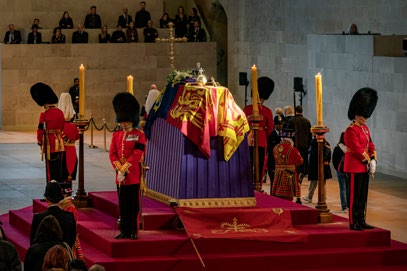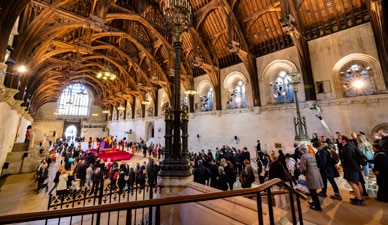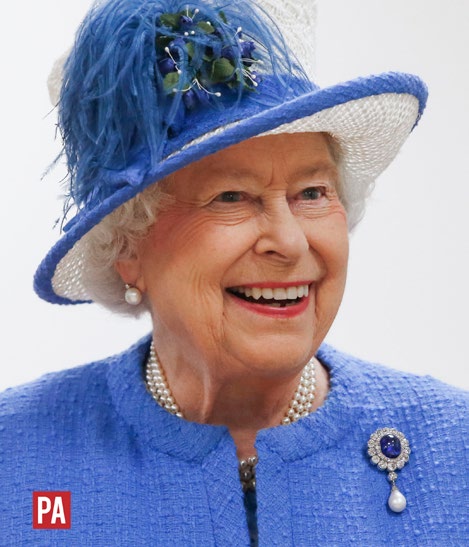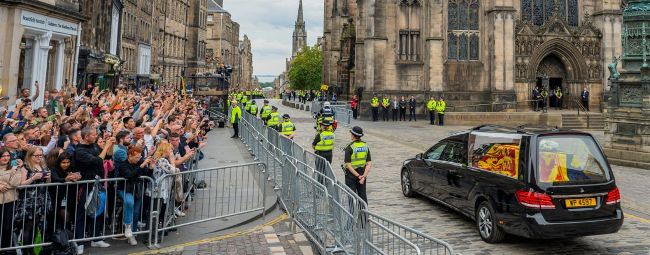COVER
A final farewell
In the month of Remembrance, Lynne McNeil reports on the days which followed the death of Queen Elizabeth II – and the unexpectedly significant role of the Church of Scotland.
SEPTEMBER 2022 will go down in the history books as a month like no other.
Within the space of a few days, Britain had a new Prime Minister, Liz Truss, who was received by Queen Elizabeth II at Balmoral. Sadly within 48 hours the Queen – Britain’s longest-reigning monarch – had died at the age of 96, after spending her last days at her beloved Balmoral in the heart of Deeside, near Aberdeen.
Within hours, messages of concern turned to messages of condolence and the Church of Scotland found itself under a global focus as never before, particularly as the Moderator of the General Assembly, the Rt Rev Iain Greenshields, had been a guest of Her Majesty at Balmoral only a few days before.
In a direct letter of condolence to King Charles III, Dr Greenshields offered a tribute: “I wish to express my own sympathy; on a personal level I deeply appreciated the time I was able to spend with the Queen last weekend. It was a great honour to be a guest at Balmoral; to receive such gracious hospitality and have the privilege of engaging in conversation with Her Majesty.”
There were numerous tributes from world leaders and many ordinary people.
Within the Church of Scotland, many wrote of the Queen’s life of service and commitment to the Christian faith.
The Very Rev Dr James Simpson, Moderator of the General Assembly in 1994 said: “On her 21st birthday the Queen declared that her whole life would be devoted to serving the British people. How faithfully she kept that promise. What unstinting service she rendered as monarch, not only to our Nation but to the Commonwealth.
“Throughout her long reign the Queen spoke often and openly of her deep Christian faith, a faith which supported her through good times and bad. In 1960 she marked the 4th centenary of the Scottish Reformation by attending our General Assembly. She returned in 1969 to show, as she told the Assembly her affection for Scotland and its Kirk. Though the official head of the Church of England, the moment she crossed the border into Scotland, she effectively became a Presbyterian, ministered to by Church of Scotland chaplains.”
The Very Rev Dr Derek Browning, Moderator of the General Assembly in 2017, who blessed the Queensferry Crossing after it was opened by Her Majesty said: “The Queen has offered the world her peerless example of selfless devotion that has brought stability and continuity. A lady of dry wit and graciousness. As we remember her she will remain an example of goodness and faithfulness that we should cherish.”
The Rev Professor David Fergusson Dean of the Chapel Royal recalled Her Majesty’s ease with people: “Paying attention to other people was another hallmark of this long and happy reign. Every teacher, healthcare worker or counter assistant knows how demanding this can be. We speak of ‘emotional labour’ – the effort involved in listening, reflecting, and responding in the right way to different needs, circumstances and personalities. The Queen gave her undivided attention, however briefly or however long, to those around her. She practised this to perfection whether it was a president or an unknown member of the public who stood before her.
“Whether this practical wisdom derived from her parents, her temperament, her experience of the war years or the responsibilities imposed by office are matters of speculation. But one thing seems clear. These habits of a lifetime were rooted in an unabashed trust in God.”
There were condolences to the Church of Scotland too from many partner organisations, with perhaps the most poignant from the Evangelical Church of Westphalia in Germany.
Dr Annette Kurschus wrote: “With sorrow and intercession we stand with the British people and the Church of Scotland in these hours and share your grief for HM Queen Elizabeth II. God blessed her with a long reign and allowed peace to grow between our countries during this time.
“We have found this to be a great gift after the times of the Second World War, in which we inflicted such deep wounds on your country. The Queen also reached out to us Christians and the churches in Germany so that reconciliation between our peoples could become a reality. We are grateful to her for this.”

Lying in State of Her Majesty Queen Elizabeth II Sunday 18 September 2022 Credit: ©UK Parliament/Annabel Moeller

Lying in State of Her Majesty Queen Elizabeth II Saturday 17 September Credit: ©UK Parliament/Roger Harris
"The Queen has offered the world her peerless example of selfless devotion that has brought stability and continuity. A lady of dry wit and graciousness. As we remember her she will remain an example of goodness and faithfulness that we should cherish.
Crathie Church, beloved by the Queen, played a role of comfort for her family, who after gathering at Balmoral attended private prayers at the Kirk, just a short distance away.
From New Zealand to Canada (and all places in between) there were requests for interviews with the Moderator, and as many former Moderators and members of the Chapel Royal who had time to offer support to the unprecedented media demand. The eyes of the world were on the Church of Scotland.
Notably at the Accession Council in London on Saturday September 10, the new King Charles III swore an oath to uphold the Presbyterian governance of the Church of Scotland – an historic part of proceedings, but which placed the Church at the heart of formalities.
The Accession Council meeting was attended by the Queen Consort, the new Prince of Wales, Prince William, and around 200 members of the Privy Council including Lord Wallace, Moderator of the General Assembly in 2021-22.
Both Royals signed the oath along with Alister Jack MP, Secretary of State for Scotland, and Nicola Sturgeon MSP, First Minister of Scotland.
As the Queen’s coffin made its final journey from Royal Deeside by road on Sunday September 11 accompanied by the Princess Royal, the Very Rev Dr Angus Morrison preached a sermon at Crathie which captured the moment, concluding: “The love and light of Christ shone brightly in her life.”
Thousands of people turned out to say a final farewell on the 175-mile road journey from Balmoral to Edinburgh and an estimated 60,000 people lined the historic Royal Mile to watch the cortege, which included the minister at Crathie, the Rev Kenneth MacKenzie, a chaplain to the Queen.
The cortege was received at the Palace of Holyroodhouse and greeted by the Rev Prof Fergusson and the Rev Neil Gardner, minister at Canongate Church on the Royal Mile.
Her Majesty lay in rest at Holyroodhouse for a night before moving along a packed Royal Mile in procession, accompanied by her four children on foot. A service of thanksgiving followed, including Psalm 23, one of the late Queen’s favourites, sung to the tune of Crimond, which was sung during her marriage in 1947 to the late Duke of Edinburgh (and featured and was repeated at services in London and Windsor).

Credit: ©Press Association/Danny Lawson
"It is clearly evident and without doubt that the Queen’s Christian faith was genuine, and often gave clear and sincere expression in those remarkable Christmas broadcasts.
During the service at St Giles’, leading the nation in mourning and thanks Dr Greenshields delivered a homily and opened by saying the nation was ‘united in sorrow’.
He added: “It is clearly evident and without doubt that the Queen’s Christian faith was genuine, and often gave clear and sincere expression in those remarkable Christmas broadcasts.
“She spoke unashamedly of her trust in God and of the example and teaching of Jesus Christ whom she sought to follow as best she could – indeed, of that faith she said she had no regret.”
After the service, the Queen’s coffin, bearing a simple wreath and the ancient Crown of Scotland, lay in rest at St Giles’ for 24 hours, where an estimated 33,000 people queued for hours to pay their respects.
Her final journey from Scotland took her along the packed streets of Edinburgh to the city airport, where she, accompanied by the Princess Royal, was moved overnight to Buckingham Palace, before processing to Westminster Hall to lie in state for four days until the morning of her funeral.
Tens of thousands of people queued to enter the Hall and say a final farewell to their Queen.
On the day of the funeral on Monday September 19, a fresh wreath was placed on her coffin bearing the simple message: ‘In loving and devoted memory, Charles R’. The wreath was created from flowers, herbs and foliage taken from the gardens of Buckingham Palace, Clarence House and Highgrove House and featured rosemary (for remembrance), myrtle, the ancient symbol of a happy marriage (cut from a plant grown from a sprig in the Queen’s wedding bouquet in 1947) and oak, a symbol of strength and steadfast duty.
During the State Funeral at Westminster Abbey, attended by over 100 world leaders including US President Joe Biden, the Moderator led a prayer: ‘O God, from whom comes everything that is upright and true: accept our thanks for the gifts of heart and mind that thou didst bestow upon thy daughter Elizabeth, and which she showed forth among us in her words and deeds; and grant that we may have grace to live our lives in accordance with thy will, to seek the good of others, and to remain faithful servants unto our lives’ end; through our Lord Jesus Christ. Amen.’
Churches in Scotland were also represented by the Most Rev Leo Cushley, Archbishop of Edinburgh and St Andrews of the Catholic Church in Scotland and the Most Rev Mark Strange, Primus of the Scottish Episcopal Church.
Fittingly following the service the late Queen was taken in procession to Wellington Arch where the coffin was moved to the royal hearse and taken by road to Windsor, where a formal guard processed to St George’s Chapel. Poignantly, the London procession moved past the Cenotaph – where the late Queen played such a significant role in Remembrance every year.
The Queen’s Domestic Chaplain from Crathie, the Rev Kenneth MacKenzie, a member of the Chapel Royal, played a key part in the final committal service at the Chapel, leading a second prayer which concluded: “We pray that, in due time, we may share with our sister that clearer vision when we shall see thy face in the same Jesus Christ our Lord.”
Capturing the Queen’s love for Scotland, her piper, Pipe Major Paul Burns played a moving lament as the public service of the ‘Queen of Scots’ came to a poignant end. ¤
Further coverage – including extracts from Life and Work’s archives on the Queen’s accession and visits to General Assemblies – are available at www.lifeandwork.org

Her Majesty Queen Elizabeth II’s coffin is pictured passing St Giles’ Cathedral
Photo: Phil Wilkinson / Alamy Stock Photo
Paying Respects to ‘The Queen of Scots’
OVER 33,000 people queued to pay their respects to the Queen as she lay at rest in St Giles’ Cathedral, the historic High Kirk of Edinburgh.
Among them was Dianne Sanderson, Life and Work’s Business Manager.
Dianne, who lives in Edinburgh, explained why she was drawn to queue for hours to say farewell to the late monarch.
“I wasn’t drawn to witness the cortege,” she says, “but the more I watched the coverage, the more I knew I wanted to pay my respects. Thankfully I found out, through talking with my family, that my husband and one of my children wanted to go too.
“My daughter said she felt she needed to go because the Queen was like ‘everybody’s gran’ and I knew what she meant.
“We calculated that maybe joining the queue overnight would give us the best (least amount) of time to wait, so at 11.30pm, we dutifully joined the back of the queue and took our places.
“We were told it would likely be about an eight hour wait. We didn’t mind.
“There was an air of quietness, a stillness around us. It felt very respectful.
“There were all kinds of people waiting around us, from way ahead to behind us as the queue kept forming. All life was there. Young people; couples; retired couples, and many single people, just standing on their own, ready to pay respect to their Queen.
“Two people mentioned they’d come from Loch Lomond; another young couple had come from Newcastle. Many had brought flowers.
“One elderly man stood alone, dressed in a black suit and black tie, silent, not interacting, just lost in his own thoughts. “An army of volunteers looked after us as we snaked round what seemed like every path in the vast stretch of grass known as The Meadows.
“Half way along, a piper played for the queue. He was standing on a bench lit only by a street lamp, playing for us all.
“By the time we reached George Square, maybe just a quarter of a mile from St Giles’, we were given wrist bands and with one last bottleneck at the security check, we were finally nearly there. One policewoman wished us ‘Good morning’ as we passed. We didn’t realise it was morning – 3.25am to be precise – we were on our way towards St Giles’.
“It was utterly peaceful. There was an atmosphere of absolute serenity and peace and of being in the right place. The lighting was subdued but perfect; the Royal Company of Archers who guarded the flag draped coffin looked dutifully steady; everything was just right. It was an occasion, a night, none of us will ever forget, and will always be glad we went to.”
Dianne added: “Members of my family have served in the Forces; some would have been there but are no longer with us, and in some ways, I did it for them too.
“In the end, I needed to pay my respects to a truly remarkable woman who, regardless of privilege, performed a role that few of us would choose, and she did it right to the end.”
“If anyone epitomised ‘Life and Work’ in the modern age, the Queen did.” ¤